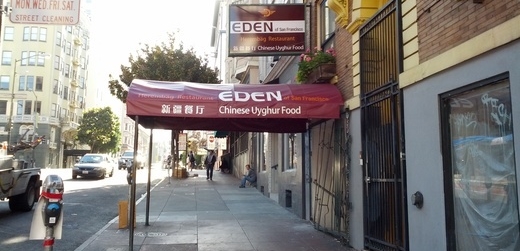
Back in April, signs of the famous Uyghur restaurant chain Herembağ (Eden) began to appear on the streets of San Francisco. A few months later, a location in Fremont was opened in a renovated hotpot restaurant with promises of a third Bay Area location in San Mateo. Like their restaurant locations from Beijing to Astana, Kazakhstan, the American version of Eden serves an upscale version of the traditional Uyghur pasta, lamb, and rice dishes, as well as Hui-inspired northwest specialties such as Big Plate Chicken (dapanji) and Turkish-style döner kebab.
To understand how Herembağ has the ambition and resources to open 20 new restaurants in North America, you have to understand how it transformed Uyghur food culture in Xinjiang.

I still remember the first time I went to one of the original Herembağs in Ürümchi back in 2010. What was remarkable about that space on Solidarity Road was the way the interior brought the ambiance of rural Uyghur courtyard houses into an upscale dining experience. The lights were low, the waiters wore white gloves, everyone drank tea out of tiny Turkish style cups — but the most intriguing thing was the way the interiors had been resurfaced to evoke the feeling of adobe (kısek); the way doorways were framed with aged wood and niches were fitted into the walls. Suddenly the homes in which many feel an uncomfortable mix of nostalgia and aversion were being evoked and reconfigured in this dining space.
The main reason many Uyghurs feel nostalgic toward courtyard houses is because they grew up in them. But due to the rapid development of Southern Xinjiang over the past two decades, many have moved into apartments in the cities and towns, and no longer have the autonomy to construct homes they can pass on to the next generation. At the same time, many recall the way those old handmade houses got so cold in the winter, how they had to haul water from a communal well and use an outhouse. Traditional Uyghur dwellings are the homes of the poor and uneducated, so they say. Given that many young Uyghurs already face feelings of lack relative to Han and Western privilege, traditional housing is sometimes thought of as “backward,” or at least incomplete.
Still, the overriding feeling many Uyghurs have toward courtyard homes is pride. They remember them as places for extended family to gather, for hosting guests, holding weddings, and sharing intimate meals with friends.

This is why the Herembağ is seen as the pinnacle of “quality” (in Chinese, suzhi; in Uyghur, sapa) for many Uyghurs visiting from the countryside. There’s tasteful and romantic Uyghur and Islamic decorations, and a proud flaunting of Uyghur heritage and traditional aesthetics. Traditional knowledge is promoted as a marker of distinction.
Of course, what is considered traditional in these restaurants is often a melding of Chinese, Turkish, and Central Asian cuisines. But these spaces also take mixes of culture and make them their own. At the flagship location on Yan’an Road in the heart of the Uyghur area in Ürümchi, live jazz, flamenco, and Uyghur pop music is played in a basement lounge every evening. Every evening the place is packed.
Over the past decade, Herembağ has established locations in every major city in Xinjiang. In addition, its monumental success has had a direct influence on the typography of menus and the designs of interiors in dozens of other large restaurants from Ürümchi to small Southern Xinjiang towns such as Payziwat. As a direct result of Herembağ’s influence, a new Turkish tea culture is emerging across the province.

Herembağ Founder Zulpiqar Ebeydulla
In addition, using a unique franchise model, the founder of Herembağ, Zulpiqar Ebeydulla, has exported this source of Uyghur pride to many major cities in Eastern China and Central Asia. In order to extract the greatest amount productivity in each branch, Zulpiqar typically finds investors to put up the cash to start a new restaurant. In return for a percentage of the profits, investors become the de-facto managers of the new restaurant and, in exchange, Zulpiqar provides the brand, training, and supply network.
To date the new location in Fremont has received slightly mixed reviews. Some guests seem unsure how to engage with the food, or how to share a meal of large plates of pasta and pilaf and Uyghur-style Chinese and Turkish dishes. Since the Uyghur managers of the new branch are dealing with the typical racism of the American “ethnic” food scene, guests often come to the restaurant expecting a certain Americanized-version of Chinese cuisine at a particular price.
I’ve yet to make it to the new locations in San Francisco. But if I do get a chance, I’ll go not just for the food, but also to remember the feeling of all of those fantastic dinners I had with friends in Chinese Central Asia.

Beige Wind runs the website The Art of Life in Chinese Central Asia, which attempts to recognize and create dialogue around the ways minority people create a durable existence, and, in turn, how these voices from the margins implicate all of us in simultaneously distinctive and connected ways.

















































They’ve got a brand-name problem. Or didn’t you notice?
A restaurant that serves “Chinese Uyghur” food?
I’ve been to them in China. I took a Kashgar friend to a “Uyghur” restaurant in Zhejiang. We ordered yoghurt. I complained to the waitress that there was a huge, unappetizing amount of sugar in the yoghurt, which is never served that way among Uyghurs, who enjoy authentic, unadulterated (and rather sour) yoghurt. “We have to make it with sugar,” she explained. “Otherwise, our Chinese customers won’t eat it.”
Can you imagine a restaurant opening stateside which describes itself as cooking, say, “Chinese Tibetan” dishes? I wouldn’t recommend that.
That would imply a rather colonial dining experience . . .
My sense is that outside of Xinjiang and Central Asia their customer base is primarily Han. Uyghur food is quite popular throughout China and among Chinese-Americans. By labeling themselves Uyghur Chinese they are continuing to market themselves to that audience in the U.S. They are also distinguishing themselves from Central Asian and other halal food sellers for ignorant Americans who still don’t necessarily know how to locate the origins of Uyghurs. And they are clearly marking themselves as non-splitist. Since their primary source of business is still in China, they are policing themselves in the same way they would back in China.